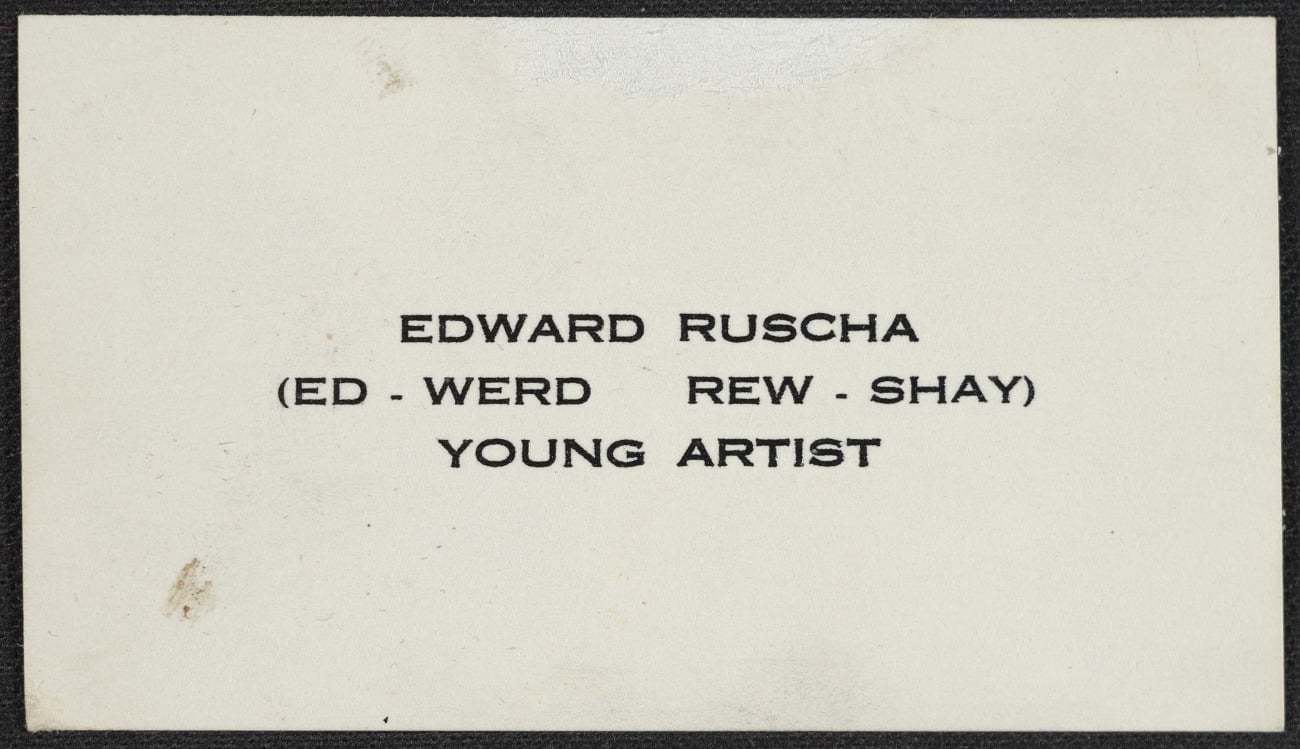
The corporate theater is perhaps the most prolific performing art venue in America. Even the acclaimed Californian artists Ed Ruscha and Billy Al Bengston have graced its venue. In 1968, the duo dropped 1,000 copies of a photo book titled Business Cards, which documents their efforts designing, fabricating, and ceremoniously exchanging business cards they’d made for each other. Most people feel in-demand if they manage to give all their business cards away. Copies of this tongue-in-cheek homage, however, sell for upwards of $5,000.
A standalone copy of the card Bengston made Ruscha appears in art critic Lucy Lippard’s archives, which now belong to the Smithsonian. The minimalist, five by nine centimeter slip of paper centers on Ruscha’s full name, with a phonetic spelling beneath it—enough to rescue art world noobs from passive aggressive corrections mid conversation. The bottom-most line of text reads “young artist.” While this was, in part, true—since Ruscha was only 31 years old at the time—it’s also somewhat of a sly joke. By then, Ruscha had already appeared in the seminal Pop Art group show New Painting of Common Objects at the Pasadena Art Museum, and staged his first solo show at L.A.’s Ferus Gallery. He was young, but incredibly established.
Ruscha met Billy Al Bengston, one of Venice Beach’s great bohemians, in the early 1960s. The two bonded over motorcycles, and art. The same year as Business Cards, in fact, Ruscha designed the catalog for Bengston’s LACMA retrospective, replete with a sandpaper cover.
“Business Cards” by Billy Al Bengston and Ed Ruscha, inscribed “For Kynaston—You owe us ten bucks & we don’t forget.” Courtesy of David Platzker @SpecificObject on Twitter.
Business Cards is an equally adventurous objet d’art, boasting a faux woodgrain Bristol board cover with a black and white photo of Bengston and Ruscha exchanging their business cards affixed to it via vintage photo corners. Nancy Rennard and Danna Ruscha can be seen in the lower left and right hand corners, respectively, watching this bit of art history unfold at Beverly Hills’ now-defunct restaurant Bistro—the site of many a power lunch. The volume’s 32 pages documenting the full process through photos by Ken Price and Larry Bell. It concludes with copies of both artists’ business cards stapled to its last page. They signed each of the editions, which have passed through the hands of Gagosian, Specific Object, the Metropolitan Museum of Art, and more.
Ruscha made 16 photo books throughout the 1960s and 1970s. Although Twentysix Gasoline Stations (1963) made the largest impact on art history, Business Cards immortalizes a bygone ritual which paved the way for the personal brand—a bit of conceptual art most Americans perform every day.
What’s the deal with Leonardo’s harpsichord-viola? Why were Impressionists obsessed with the color purple? Art Bites brings you a surprising fact, lesser-known anecdote, or curious event from art history.